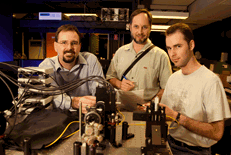|
News & Views item - November 2007 |
![]() Australian's Perform "The Most Accurate Measurement Ever Made".
(November 15, 2007)
Australian's Perform "The Most Accurate Measurement Ever Made".
(November 15, 2007)

From left to right Geoff Pryde,
Howard Wiseman
and Brendon Higgins
While unintended, work carried out over the past year at Griffith University, Brisbane is a salient reminder that not all work of scientific brilliance is a product of Australia's Group of Eight.
In today's issue of Nature B. L. Higgins1, D. W. Berry2, S. D. Bartlett3, H. M. Wiseman1,4 & G. J. Pryde1 report on measurements made on a quantum system at the greatest precision theoretically possible.
The methodology developed in Geoffrey Pryde's Centre for Quantum Dynamics is limited only by Heisenberg’s uncertainty principle, the most fundamental and unavoidable source of imprecision in the quantum world. It is impossible to measure some pairs of properties -- for example, position and momentum of a quantum particle simultaneously beyond a certain limit which is defined by the Heisenberg’s uncertainty principle.
As Nature's Phillip Ball describes it: "Pryde and his co-workers in Australia have demonstrated a way of reaching the Heisenberg limit of measurement precision without needing these elusive states [of quantum entaSnglement] by looking at photons traversing an interferometer's arms one at a time. The key is to avoid making measurements that determine which arm the photon is in, until the beams are recombined at the end. This allows the [quantum]shot noise to be more or less smoothed away."
Časlav Brukner, a quantum optics expert at the University of Vienna told Ball: "It is really surprising that using only single photons, they can achieve the Heisenberg limit. This work could lead to significant improvements in high precision interferometry."
Jonathan Dowling,a physicist at Louisiana State University in Baton Rouge confesses that he was very sceptical that it could be made to work when the team announced their plans at a conference at the start of the year. "I am now forced to eat my hat," he told Nature's Ball.
The experiments were performed by Dr Pryde and his PhD student Brendon Higgins.
According to the universities media release, Quantum Dynamics Centre Director, Professor Howard Wiseman, developed the theory, together with University of Sydney's Dr Stephen Bartlett and Macquarie University's Dr Dominic Berry.
"Similar schemes based on interferometry – a technique using waves of
electromagnetic radiation such as light – have been used for centuries
to measure length, and other properties of objects, with great
accuracy." Professor Wiseman said.
"The key difference is we have done it in a way that gets as much
information out of each pass of a photon through the sample as is
allowed by Heisenberg's uncertainty principle. In this sense, it’s the
best measurement possible – something that’s never been done before."
Dr Pryde said: "The obvious applications are in making accurate
measurements using less light than was previously thought possible. This
is particularly important in fields such as medical research, as passing
light through a biological sample can damage it."
This work should serve as a caveat to those, such as the current Minister for Education, Science and Training as well as some from within academe, that the over simplistic restricting of research efforts to a chosen few establishments can cause unwarranted damage to Australian research and the training of our young researchers.
Jonathan Dowling writing in the "News and Views"
section of the November 15, 2007 issue of Nature summed up the
groups work: "So what is the immediate lesson to be learned? That tricks
from quantum computing will find their practical near-term
implementation in spooky gizmos with scientific and practical
importance, but nothing to do with computers at all. Bravo!